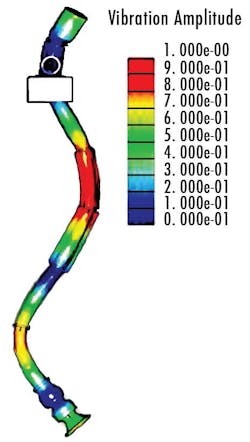High vibration is a common problem for motors that are installed on top of vertical pumps. Its source can be a mechanical issue with the pump, motor or coupling or even hydraulic forces from the pump. Structural issues involving “reed frequency” resonance often amplify the problem, but effective diagnosis must begin with an understanding of the underlying vibratory forces. Although the general vertical pump category includes submersibles, this article focuses solely on the ones that most commonly exhibit high-vibration conditions: surface-mounted pumps with the motor bolted to a pedestal on top (see Image 1).
Mass unbalance
As with all rotating machinery, the most common vibratory force for vertical pump motors is mass unbalance. Unfortunately, accurate balancing of the rotor in a balancing machine will not eliminate all sources of unbalance for these motors. Often the top thrust bearing mounts onto a carrier hub, which is a clearance fitted to the shaft and locked in place by a shaft nut. This creates unbalance by allowing some variance of the rotating axis in relation to the principal axis of inertia.
On hollow shaft designs, the massive hub that mounts to the top of the rotor is subject to unbalance and eccentric mounting. It may even have moving parts for the anti-reversing ratchet, which can add to the problem. The pump shaft on these designs passes through the motor shaft and bolts to the top hub. Mass unbalance will result if the pump shaft and retaining hardware are slightly eccentric.
Coupling type & alignment
The type and alignment of the coupling also can cause vibration in vertical pump motors. On hollow shaft designs, the coupling consists simply of the bolts that secure the motor shaft to the top hub. The only flexible element in this drive train is the pump shaft, so any offset or angular misalignment of the pump shaft and hub will produce significant vibratory forces.
An alternate design couples the pump shaft and motor at the bottom of the motor. Here, too, the coupling that supports the weight and thrust of the pump is often solid rather than flexible. This greatly increases the chances for vibration as compared with conventional, horizontally mounted, flexible couplings.
Mechanical action of pump shaft & impeller
Another vibratory force that often affects the kinds of vertical pump motors discussed here is the mechanical action of the pump shaft and impeller. These pumps have long, slender shafts that are susceptible to twisting and bending, so they usually have guide bearings at intervals along the casing to provide stability. Any variances in guide bearing clearances can make the pump shaft “dance” or “whip,” especially on very deep pump applications.
Hydraulic action of fluid
The hydraulic action of the pumpage as it moves through the pump casing and out the discharge piping is another significant vibratory force that can affect vertical pump motors. The discharge from most of these pumps is horizontal, so the fluid must make a 90-degree turn, usually at the top of the pump and just below the motor. Flow turbulence at this location can be a strong, exciting force.
Resonant frequencies
All machines have resonant frequencies due to the stiffness and mass of their structures. Design engineers try to keep these frequencies well above (or below) those of any exciting force by stiffening the structure or adding mass. The process is similar to tightening a guitar string to raise its pitch, or strumming one of the thicker (more massive) strings to play a lower note.
Although resonant frequencies are potentially present in horizontally mounted pumps and motors, the base structures of these machines can usually be engineered to withstand them. By contrast, the long moment arm created by a tall motor mounted atop a pump flange makes it difficult to build in the required structural rigidity. This results in resonance frequencies that may be low enough to coincide with and amplify any vibratory forces present.
Vertical pump troubleshooting checklist
Before trying to identify resonant frequencies that may contribute to vertical pump vibration problems, check and adjust everything that can prevent severe vibration:
- Ensure the mounting flange is stiff enough to raise the resonant frequencies well above those of the operating speed and other exciting forces.
- Adjust the mechanical alignment and balance to within reasonably tight tolerances.
- Make sure the hydraulic flow through the pump and piping is smooth, not turbulent.
To see how this applies to vertical pumps, try holding a simple metal ruler at one end and striking the other. The tone you hear is the ruler’s natural (or reed) frequency. Like the ruler, a vertical pump motor is attached (to a structure) at one end and free at the other. The stiffness of its supporting mounting flange depends on the foundation, especially on how well the pump is bolted to that foundation. Of course, the pump that hangs below the mounting flange also has significant mass with its own resonant frequencies, as does the attached discharge piping.
In relation to the whole machine, the flange to which the pump, motor and discharge piping attach looks pretty small and weak, offering abundant opportunities for resonant frequencies in various ranges. This might be good for making music, but to most maintenance professionals, it sounds like trouble.
Before trying to identify resonant frequencies that may be contributing to vertical pump vibration problems, check and adjust everything that can prevent severe vibration:
- Ensure the mounting flange is stiff enough to raise the resonant frequencies well above those of the operating speed and other exciting forces.
- Adjust the mechanical alignment and balance to within reasonably tight tolerances.
- Make sure the hydraulic flow through the pump and piping is smooth, not turbulent.
Basic frequency analysis
Any attempt to solve vibration problems on vertical pump motors should begin with a basic frequency analysis using a portable vibration analyzer. In most cases, a single vibration frequency will be dominant – often at rotating speed. Then, by simple process of elimination, users can zero in on the source of the problem.
If rotating speed is the dominant frequency, the problem is not hydraulic forces from the pump. If rotating speed is not the dominant frequency, then neither unbalance nor misalignment is a source of vibration. Conducting a simple bump test can identify the resonant frequencies of the mounted motor. From here, it is a fairly straightforward process to identify other contributing factors using phase analysis and operating deflection shape (ODS) analysis.
Vibration at 1 x rpm is by far the most common occurrence, so it merits attention. Phase analysis can confirm that the vibration is at 1 x rpm, and amplitude and phase data from various locations on the motor and pump flange can generate a “picture” of the vibratory motion. With ODS analysis, computer software animates the motion based on phase and amplitude vectors (see Figure 1). Although this can be very useful, a simple pencil sketch with the vectors plotted will often provide adequate information.
Trim balancing
Placement of trim balancing weights in an attempt to reduce vibration can be an important diagnostic step. Convenient locations for the weights are on the coupling hub and the fan at the top of the motor. A resonant condition exists if very small weights significantly change the amplitude and phase vector. If reducing the vibration in one direction causes an increase in the other (for example, north to south and east to west, respectively), unbalance is not the primary exciting force; suspect misalignment or a warped pump shaft.
Other possibilities
When vibration is not at rotating speed, the process of elimination must consider a number of other possible forces. Basic vibration analysis techniques, while not covered here, can help to isolate the most likely causes. While the motor is usually the focus of attention, the pump, perhaps unseen below the surface, can also generate vibratory forces that will be reflected in the motor vibration.
Even a seemingly simple case of vertical pump motor vibration can take the vibration technician on an analytical journey. By recognizing that resonance, pump-generated forces, and the interaction between the motor and the pump shaft can all be contributing factors, the technician can approach the problem objectively and use process of elimination to solve it. Those who approach the problem unprepared may find only frustration.
Eugene Vogel is a pump and vibration specialist at the Electrical Apparatus Service Association (EASA) in St. Louis, Missouri. EASA is an international trade association of more than 1,900 firms, which sell and service electrical, electronic and mechanical apparatus, in 59 countries. Contact EASA at 314-993-2220 or by fax at 314-993-1269, or visit online.
EASA





